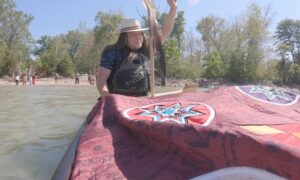Young Anishinaabe man journeys along Lake Huron to bring understanding on troubled relationships with water, First Nations and settlers

By Colin Graf
KETTLE & STONY POINT FIRST NATION— A young man from Kettle & Stony Point (KSP) First Nation and the Saugeen Ojibway Nation (SON) is on a 28-day canoe journey along the shore of Lake Huron to help others understand the importance of the lake and the complex and troubled relationship between the water, First Nations, and settler populations.
Waasekom Niin is adding the trip to his already impressive paddling achievements, including a voyage in 2016 from Sault Ste. Marie to Stony Point, and a 97-day odyssey the next year, travelling the entire length of the Great Lakes, from Duluth, Minnesota, at the western tip of Lake Superior, to Matane, Quebec, almost at the Gulf of St. Lawrence.
His latest trip and the video recordings being made while travelling aim to highlight the Indigenous title claims being made to the water, lake bed, the shores, and rivers flowing into Lake Huron, Waasekom says.
He supports the multi-billion dollar claims by Saugeen and the Nawash (Cape Croker) Unceded Territory that are currently before an Ontario court, and hopes “to build relationships with the water and the people along our way” during his trip.
A major concern for Waasekom is the Bruce Nuclear facility, north of Kincardine, which “is siphoning off an Olympic-sized swimming pool of water” every seven seconds for cooling the nuclear process. The water is returned to the Lake 10 degrees warmer, he says, “which is measurable and actually has an impact on the fishery.”
“We’re not saying they can’t take the water, because nuclear power wouldn’t exist without it, but what are you doing to actively give back for that taking?” he asks.
“We (First Nations) have a say and a role,” he says in regards to decisions about how the water should be used.
The paddler’s goal is “to bring the voice of the water into these decision-making processes.”
“We need to take the consultation process to the next level. We are decision-makers in our own territory, we should be sitting side-by-side with the regulator and the proponent,” he insists, adding that also in water use applications, not consulted separately.
The recent cancellation of plans to build an underground depository for low-level nuclear waste from the Bruce power plant is a victory for SON and others who supported the community in opposing it, says Waasekom. Last winter, 85% of voters at Saugeen rejected the proposal by Ontario Power Generation (OPG), killing off hopes for the chamber that would have been built more than half a kilometre underground near SON territory.
“They (OPG) did what they said they would do, and that’s good. They’re honouring their word. It’s really positive for our nation to go up against major proponents and hold our own ground; that’s a big deal,” he says after OPG’s 15 years of efforts to create the depository come to an end.
For Waasekom Niin, issues in the relationship between First Nations, the settler community, and Lake Huron go beyond the taking of water and the disposal of contaminated waste. For all people living in the area “there’s always this question of what it means to be a treaty person,” he says. For that reason, he wants to bring attention to the legal cases that are trying two different claims by the SON.
In the first claim, the Saugeen Ojibway is seeking ownership of government land across the Bruce Peninsula, including national parks, road allowances, rivers, and lakes. Privately owned property is exempt from the claim. The second claim covers the waters of Lake Huron north from the Goderich area, around the peninsula, and through part of Georgian Bay near Collingwood.
Also important to Waasekom is that his community is asking the court to affirm their rights to hunting and fishing within their traditional territory were never surrendered.
Treaty provisions state certain islands on Lake Huron and on the Georgian Bay side of the Peninsula “belong to us, but when you go there, all those islands are privately owned. You’ll see those signs that say ‘No Trespassing, Private Property,’” he explains.
“There’s all this assumed ownership in our territory. There’s profound racism if you try to go on, quote-unquote ‘somebody’s land”; but really that land is still in question in terms of traditional access and use.”
The canoe trip is meant to explore and document these stories. Working with a filmmaker on a series of short videos, the long-distance voyager hopes to create a series of short videos and share them “strategically” with various people involved in matters of the treaties, such as politicians. He hopes to give these influencers a new perspective on the issues.
As of July 12, the trip had reached SON and Waasekom Niin was holding ceremony with community members. While also observing coronavirus disease 2019 (COVID-19) pandemic protocols like social distancing, before heading further north. The journey can be followed at Picking up the Bundles Canoe Journey on Facebook. Waasekom’s GPS tracker precise location can be tracked from the same page.
With a background first in culinary school and then studying at Trent University, Waasekom has also worked for the Chiefs of Ontario, for the Independent First Nations organization, as well as stints working for both his ancestral communities. Last January he was awarded a $75,000 Changemaker Fellowship by the NDN Collective in the U.S.A. That group offers the 12-month fellowships to 21 “Indigenous Changemakers each year across Canada, the United States, and Mexico, who are working to defend, develop, and decolonize their communities and Nations,” the group’s website states.


